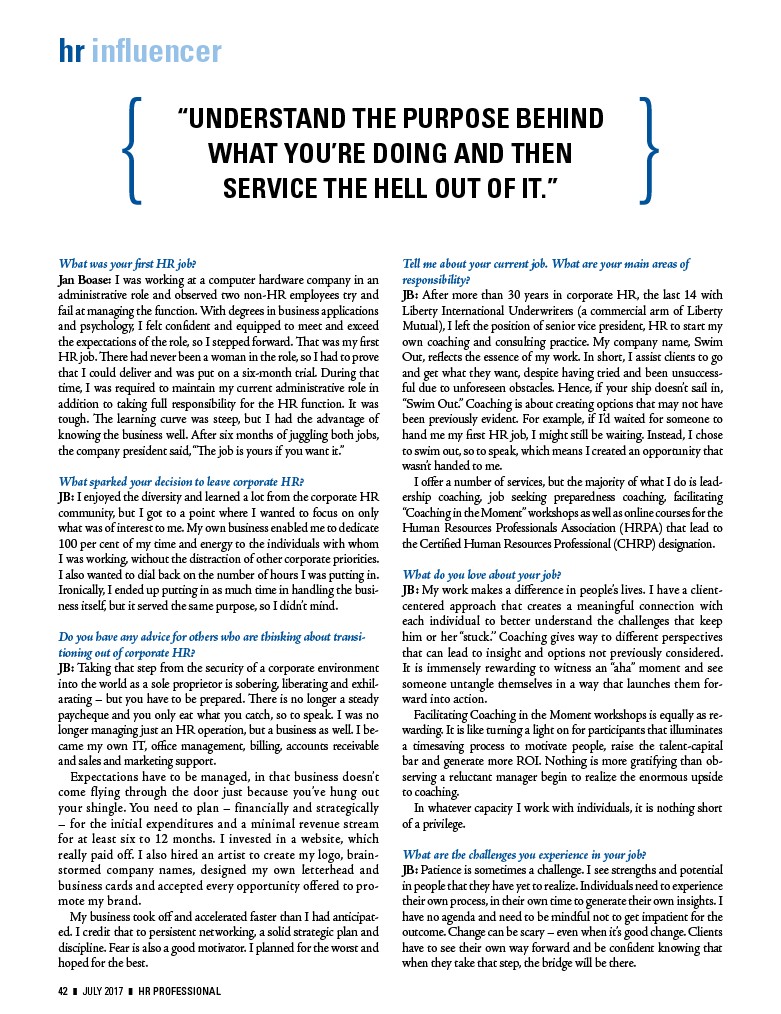
hr influencer
“UNDERSTAND THE PURPOSE BEHIND
WHAT YOU’RE DOING AND THEN
SERVICE THE HELL OUT OF IT.”
What was your first HR job?
Jan Boase: I was working at a computer hardware company in an
administrative role and observed two non-HR employees try and
fail at managing the function. With degrees in business applications
and psychology, I felt confident and equipped to meet and exceed
the expectations of the role, so I stepped forward. That was my first
HR job. There had never been a woman in the role, so I had to prove
that I could deliver and was put on a six-month trial. During that
time, I was required to maintain my current administrative role in
addition to taking full responsibility for the HR function. It was
tough. The learning curve was steep, but I had the advantage of
knowing the business well. After six months of juggling both jobs,
the company president said, “The job is yours if you want it.”
What sparked your decision to leave corporate HR?
JB: I enjoyed the diversity and learned a lot from the corporate HR
community, but I got to a point where I wanted to focus on only
what was of interest to me. My own business enabled me to dedicate
100 per cent of my time and energy to the individuals with whom
I was working, without the distraction of other corporate priorities.
I also wanted to dial back on the number of hours I was putting in.
Ironically, I ended up putting in as much time in handling the business
itself, but it served the same purpose, so I didn’t mind.
Do you have any advice for others who are thinking about transitioning
out of corporate HR?
JB: Taking that step from the security of a corporate environment
into the world as a sole proprietor is sobering, liberating and exhilarating
– but you have to be prepared. There is no longer a steady
paycheque and you only eat what you catch, so to speak. I was no
longer managing just an HR operation, but a business as well. I became
my own IT, office management, billing, accounts receivable
and sales and marketing support.
Expectations have to be managed, in that business doesn’t
come flying through the door just because you’ve hung out
your shingle. You need to plan – financially and strategically
– for the initial expenditures and a minimal revenue stream
for at least six to 12 months. I invested in a website, which
really paid off. I also hired an artist to create my logo, brainstormed
company names, designed my own letterhead and
business cards and accepted every opportunity offered to promote
my brand.
My business took off and accelerated faster than I had anticipated.
I credit that to persistent networking, a solid strategic plan and
discipline. Fear is also a good motivator. I planned for the worst and
hoped for the best.
Tell me about your current job. What are your main areas of
responsibility?
JB: After more than 30 years in corporate HR, the last 14 with
Liberty International Underwriters (a commercial arm of Liberty
Mutual), I left the position of senior vice president, HR to start my
own coaching and consulting practice. My company name, Swim
Out, reflects the essence of my work. In short, I assist clients to go
and get what they want, despite having tried and been unsuccessful
due to unforeseen obstacles. Hence, if your ship doesn’t sail in,
“Swim Out.” Coaching is about creating options that may not have
been previously evident. For example, if I’d waited for someone to
hand me my first HR job, I might still be waiting. Instead, I chose
to swim out, so to speak, which means I created an opportunity that
wasn’t handed to me.
I offer a number of services, but the majority of what I do is leadership
coaching, job seeking preparedness coaching, facilitating
“Coaching in the Moment” workshops as well as online courses for the
Human Resources Professionals Association (HRPA) that lead to
the Certified Human Resources Professional (CHRP) designation.
What do you love about your job?
JB: My work makes a difference in people’s lives. I have a clientcentered
approach that creates a meaningful connection with
each individual to better understand the challenges that keep
him or her “stuck.” Coaching gives way to different perspectives
that can lead to insight and options not previously considered.
It is immensely rewarding to witness an “aha” moment and see
someone untangle themselves in a way that launches them forward
into action.
Facilitating Coaching in the Moment workshops is equally as rewarding.
It is like turning a light on for participants that illuminates
a timesaving process to motivate people, raise the talent-capital
bar and generate more ROI. Nothing is more gratifying than observing
a reluctant manager begin to realize the enormous upside
to coaching.
In whatever capacity I work with individuals, it is nothing short
of a privilege.
What are the challenges you experience in your job?
JB: Patience is sometimes a challenge. I see strengths and potential
in people that they have yet to realize. Individuals need to experience
their own process, in their own time to generate their own insights. I
have no agenda and need to be mindful not to get impatient for the
outcome. Change can be scary – even when it’s good change. Clients
have to see their own way forward and be confident knowing that
when they take that step, the bridge will be there.
42 ❚ JULY 2017 ❚ HR PROFESSIONAL